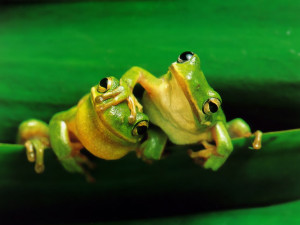
Frogs are simple creatures. They can make cute companions and will live long, healthy lives if taken care of properly. You need to know though, that there are many frogs which are endangered and becoming extinct due to human intervention. It is important to buy pet frogs that are surely locally captive bred and tested to be disease-free. This way you can avoid taking part in the extinction crisis caused by the pet trade, as well as the horrid Chytrid fungus infection.
Pet Frog Facts:
- Pet frogs tend to live from 4 to 15 years with proper care.
- Most large frogs don’t move around a lot, while smaller frogs are active.
- Keeping a pet frog means that you need to dedicate a lot of time cleaning its enclosure. Frogs don’t need highly accurate humidity and temperature requirements, but they are susceptible to infection and contamination in their environment.
Frogs as pets are not very common, that’s why you need to do a lot of research before you decide on getting one. Find out what type of breed you want to take care of and what it needs so that you can give him a happy life. You’re first priority is that you need to get a tank for the frog before you buy one.
When off to buy a tank, consider the following:
- The type of tank you’ll need based on the frog that you want to get. Will it be a terrestrial, aquatic, semi-aquatic, or arboreal frog?
- The full size of your future pet frog. Don’t determine the size of the frog based on what it looks like in the pet store. Tiny frogs can grow into giants. Ask the pet store attendant about their full size or get the frog’s scientific name and research on it.
- If the type of frog that you’ll be getting hibernates or not.
- The type of food it eats such as insects or even pinkie mice.
Selecting your pet frog
Before moving on, think about how much of your time, effort, and money do you want to commit to your pet frog? Frogs are living creatures and need to be properly taken care of. They need a good, clean environment and enough food to eat, so you need to determine how dedicated you are before you get one.
- Go through several nearby pet stores before buying a pet frog so that you can check on the price and the health of their frogs.
- If you want an inexpensive breed of frogs as pets then you can research on any one of the following:
- Barking Tree Frogs
- Pac Man Frogs
- White Dumpy Tree Frogs
- African Clawed Frogs
- Green Tree Frogs
- An inexpensive pet doesn’t mean that everything else will be cheap though. Prepare to spend more on its cage and accessories such as substrate, water dish, food, plants, and lighting features. For example, aquatic frogs need to have their water changed often. Tree frogs need moist air so you will need a tank-mister or at least a spray bottle.
- Here are some more items that you will likely need to give your pet frog a healthy and safe environment:
- Tank (aquarium, terrarium, etc.)
- Water dechlorinating solution (for aquatic and semi-aquatic frogs)
- Water test kits
- Plants
- Tank heaters and lights
- Tank (aquarium) screen covers
- Powdered vitamins
- Food (crickets, mealworms, larvae, etc)
- Remember that if you can’t take care of the frog, don’t buy one. If you’ve already bought one but figured out that you can’t care for it, don’t send it off to the wild. It will die or destroy the environment. Give it to someone who can take care of it.
Taking care of frogs as pets
- The tank (terrarium) and the tank stand should be solid and strong. Try to get a fish tank stand or use a desk.
- Don’t put the frog’s tank near any direct sunlight, in a small, enclosed room, or the basement. The room should have proper heating and air conditioning.
- It’s not going to be a good idea to put your pet frog inside your bedroom because some of them tend to be quite noisy at night.
- The bottom line is that if you don’t have proper space for your frog in the house, its best for you not to get one.
- The water that you give to your pet frog should be de-chlorinated. When changing the water, do not change it entirely as the sudden change of temperature may shock the frog. Change about 2/3 of the water every three days.
- When cleaning the tank, do not use any toxic cleaners. Simply use plenty of water and Bactine.
- When you have your tank, add water and plants to give your frog a comfortable, homey environment. You need to cover the tank well so that they won’t be able to escape. Ensure that the tank is well ventilated.
- Make sure that the recommended temperature is maintained for your frogs. Find out what type of temperature is right for your frog. This will be from room temperature up to 80 degrees.
- Frogs like food that moves so give it the type of food that the pet store attendant recommends or based on what you’ve researched. Don’t over feed your frog.
- If your frog starts to behave differently, do research on its breed and symptoms of particular diseases. Bring your pet frog to a vet as soon as possible. A common frog disease is Red Leg disease wherein the frog’s legs and underside turn red.
- Frogs molt, so this is not a sign of any disease. They also tend to hibernate so they appear still and unmoving while concealed. Do not disturb it if it is doing so, just check if it’s still breathing.